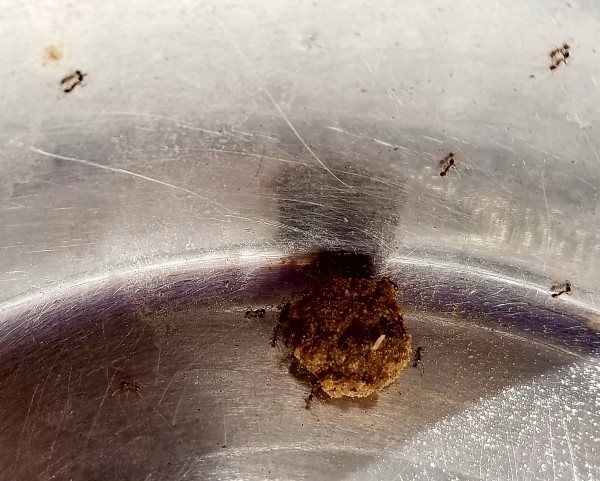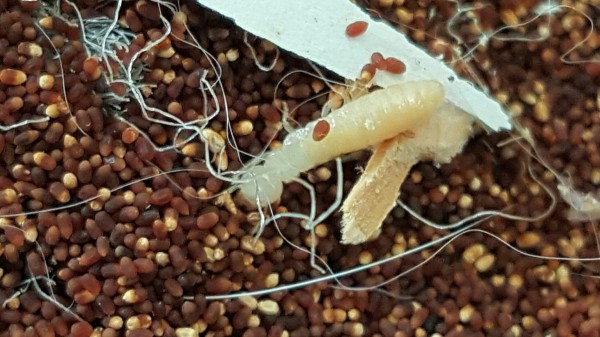First off, the good news, we don’t have snakes in Hawaii! That being said, Hawaii’s tropical climate is enjoyed by more than just humans, namely centipedes, cockroaches, spiders, ants, termites, and rodents. At some time or another during your residency here in Hawaii, you will encounter these creatures, no matter how clean you keep your house.
Centipedes
Centipedes in Hawaii average 5-6 inches with some monstrous specimens reaching up to 9-12 inches. They can pack a venomous punch, similar to a wasp sting, with their piercing fangs, located on the head. If you do happen to encounter a centipede, my preferred method of removal involves kitchen scissors and an oven mitt. Grab it with the mitt, snip it to bits, and flush the bits down the toilet. Problem solved.

A pulverized centipede
Cockroaches
Cockroaches are a fact of life in the tropics. I’ve seen them in single-wall construction plantation homes to multi-million dollar estates. Your best defense here is to keep your kitchen as clean as possible and to use roach traps and/or an exterminator.

A cockroach, most commonly found in kitchens and bathrooms
Spiders
Thankfully most spiders seem to stay outside, but the occasional Daddy Longlegs/Harvestmen have been known to enter and make cobwebs in corners and leave annoying white droppings on dark hardwood floors that must be scrubbed off. At least they eat small insects. The Cane Spider is a large hairy spider with a leg span of 3-4 inches. Even though it looks like something out of the movie Arachnipobia, it’s harmless and rarely bites. On the bright side, they don’t spin webs and they can eat even the largest of cockroaches.

The scary yet harmless Cane Spider
Ants
In Hawaii we have an abundant number of ant species with diets ranging from carbohydrates, fats, proteins, and wood. When buying ant traps, it’s best to buy the type that targets your ants’ personal preferences. It’s recommended to keep your kitchen clean and to store all pantry items in airtight containers.

An army of ants attacking a remaining kibble in the dog’s bowl
Termites
We have two types of termites in Hawaii, the Subterranean Termite and the Drywood Termite.
Subterranean Termites colonize in the ground and do the most structural damage to a home in a small amount of time. Keep the concrete foundation around your home free of excessive moisture to prevent infestation. Some homeowners have gone so far as to line the perimeter of their home with gravel or concrete for this reason.
Drywood Termites don’t require contact with the soil and often just cause localized damage due to their colony size. The tell-tale droppings usually look like sand granules. A termite inspection is required in all real estate transactions (except cash) 14 days prior to close. Most financing requires this inspection.

A close-up of a termite and its sand-like droppings
Rodents
The tiny house mice in Hawaii look like characters from a Beatrix Potter tale and are rather unassuming. The best way to catch them is with sticky traps and poison bait stations. Keep trees well-trimmed and away from your roof to prevent attic infestations. Do not leave ripe fruit on trees or on the ground as this will attract rats. The best way to control rats is to remove water sources and use snap traps and bait stations.
If these methods don’t appeal to you, the helpful staff and volunteers at the Maui Humane Society will gladly help you find a cat/dog that is a good mouser/ratter.

Keiki, a small terrier/blue healer mix, has proven to be an excellent ratter
The Best Offense is a Good Defense – Quick Tips
- Install screens on all windows and doors. Make sure there are no gaps or open cracks. Now make sure the screens are closed at all times.
- Favorite entry points are spaces between floor boards, walls, and molding. Fill these areas with caulk.
- Rodents also dislike the feel of steel wool in their noses and paws. Holes can be filled with steel wool or expansion foam and sealed.
- Choose a reputable pest control company to help in your fight against unwelcome guests. They can maintain all bait stations, spray indoors and out, all with regard for pets and children.
Want to Know More?
If you have any questions, please don’t hesitate to contact me.




johnwan
September 7, 2017
This is creepy.
Annie Frances
September 17, 2017
I cannot believe centipedes in Hawaii average up to 6 inches long! That’s like straight out of a horror movie. When I was vacationing in Waialua I saw some pretty huge bugs. I felt like the people in the area could not handle these monsters with just your average store-bought bug spray. I think everyone who lives in Hawaii should have a professional handle this issue. http://www.servicewithaloha.com/
Anonymous
November 9, 2018
“Grab it with the mitt, snip it to bits, and flush the bits down the toilet. Problem solved.”
That’s…disturbing.
Blain Stutts
July 20, 2020
They do have snakes in Hawaii